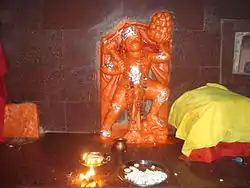Khohari
Khohari is a village in the Behror tehsil the Alwar district of Rajasthan state in India, with a population of around 2800.
Khohari | |
|---|---|
village | |
 Khohari hanuman temple | |
 Khohari Location in Rajasthan, India  Khohari Khohari (India) | |
| Coordinates: 27°54′47″N 76°13′38″E | |
| Country | |
| State | Rajasthan |
| District | Alwar |
| Languages | |
| • Official | Hindi |
| Time zone | UTC+5:30 (IST) |
| ISO 3166 code | RJ-IN |
| Nearest city | Behror |
Location
Khohari is located 8 km from Rajasthan's northeastern border with Haryana and 8 km from National Highway 8, 6 km from Behror, and 2 km from state highway 14at Nasarupr. It is connected with all major metro cities of India, such as New Delhi (140 km), Gurgaon (102 km), Jaipur (132 km) by National Highways of India. Indira Gandhi International Airport at New Delhi is 132 km and Jaipur International Airport is 130 km from the village. Alwar is 70 km away. khohari is surrounded by Khapariya to the south, Banhad to the west, Hameedpur to the east, Maharajwas to the north and nasarupr to the northeast. In the southwest village surrounded by the Aravalli Range. It is connected with all surrounding villages by roads.
History
There is no clear evidence but it is believed that khohari was founded about 1850. The village was first founded in the valley of the Aravalli Range and was later established 1 km to the east of the Aravalli Range.
Culture
Due to its location, the village culture has been influenced by Haryana. Rath is the main spoken language. Khohari is a village of 100% Hindu population, hence the culture involves all Hindu festivals and rituals. Holi, Deepawali, Gangaur, and Raksha Bandhan are the major festivals. The village has two temples, to Hanuman and to Shiva.
Economy
Formerly, the economy of Khohari was based mainly on agriculture and government employment, predominantly in teaching, the army and the police services, but this has lately been undergoing a change because of the poor financial prospects in agriculture and greater awareness of the importance of education. The village has all basic facilities, including one private school and two government schools for education up to the class of ten; a post office and a water supply system.
Education
In the past, education was lacking, but is now the top priority of the villagers.
Gallery
 Main gate of temple
Main gate of temple Hanuman temple
Hanuman temple Radha Krishna mandir
Radha Krishna mandir Hanuman temple gate
Hanuman temple gate A front view of temple
A front view of temple Samadhi
Samadhi Samadhi garden
Samadhi garden